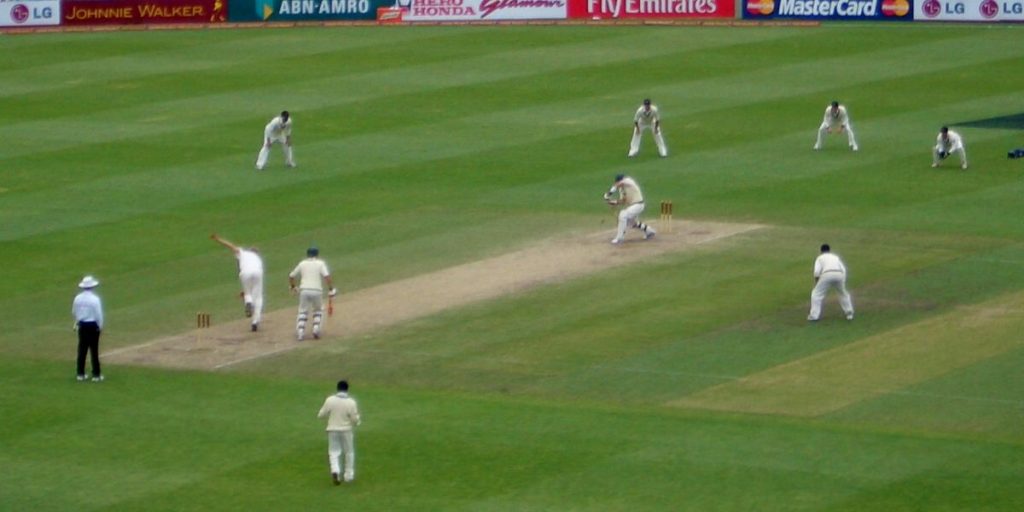Cricket is one of Australia’s most popular summer sports. Although strictly a non-contact sport, injuries in cricket can result in a number of ways.
The best cricket injury research has come from Australia under the direction of Dr John Orchard. Cricket injuries at elite level In Australia have been demonstrated to occur at a rate of around 18 injuries in total for a squad of 25 players who play twenty matches in a season. On average, around 9% of cricketers have an injury at any given time, although in fast bowlers that rate is significantly higher.
The pace of cricket, hazards of the play and expectations of the players have all increased over time. In addition, there are very different physical demands involved in different types of cricket, which has meant the injury profile is slightly different between five day test matches and one day matches. The launch of Twenty20 cricket has placed a new physical requirement on cricketers, although it is too early for the effects of these demands to be analysed in sports injury research.
Low back pain is particularly prevalent among younger fast bowlers. The repetitive action of bowling for long spells places excessive stress on the tissues of the lower back, where stress fractures of the vertebra (spondylolysis) can develop.
Research has indicated that muscle injuries such as hamstring strains and side abdominal strains are the most common cricket injuries. These injuries are due to the functional load demands of the sport where occasional sprinting and ball throwing may be repeated across potentially a seven hour day.
Five Common Cricket Injuries
Hamstring Strains
A hamstring strain is a tear in the muscle tissue. Hamstring strains tend to affect all cricketers regardless of position and account for around 15% of all cricket injuries. Hamstring strains tend to occur during explosive sprinting activities such as bowling, taking a quick single or fielding a ball.
Because of the sudden stress on the muscles, the hamstrings can be loaded beyond their capacity and the muscle tissue can be torn. Any muscle tear is referred to as a strain and depending on its severity, it may be classified as a first, second or third degree strain.
What can you do to prevent a hamstring strain?
In bowlers, especially fast bowlers there is a positive link between ‘over bowling’ and sustaining a hamstring strain. Over bowling can be avoided by recording a log of each bowler’s workload to prevent sudden overload.
A warm up prior to cricket is designed to decrease muscle injuries because the muscle is more extensible when the tissue temperature has been increased by one or two degrees. A good warm up should last at least 10-15 minutes, starting gently and finishing at full pace activity.
What should you do if you suffer a hamstring strain?
If you have a hamstring strain follow the RICE protocol – rest, ice and compression and elevation (never apply ice directly to the skin).
Contact one of our physiotherapists regarding rehabilitation. Most hamstring strains will be fully healed within 4-6 weeks, but recurrent problems can occur when a return to play is attempted too early or without proper rehabilitation.
For a more detailed discussion about hamstring strains and their management follow the link Dealing With Hamstring Strains.
Low Back Pain
Low back pain is the general term for any pain in the back. The repetitive action of bowling is the biggest cause of low back pain in cricket, but bending to field the ball and standing in the field for prolonged periods also put stress on the back which can cause back pain.
Any structure of the lower back can be affected – the discs, ligaments, muscles or Facet joints – but in fast bowlers, particularly younger ones, the most commonly affected part of the lower back is the ‘pars interarticularis’ area of the lumbar vertebra, where a stress fracture can develop. This is characterised by a back ache following cricket often lasting several hours, particularly when bending backwards.
What can you do to prevent low back pain?
Fast bowling in cricket requires a combination of spinal hyperextension (bending backwards) together with rotation and side bending of the trunk. When repeated this puts excessive stress on an area of the vertebra called the pars interarticularis and this is where a stress fracture develops.
Bowling practice should be carefully monitored to ensure the lower back is not being overloaded. This is particularly important in adolescent players who have just experienced a growth spurt as they are known to be more at risk from this injury. Core stability exercises are important to prevent back problems in cricket players and well fitted footwear with good cushioning can help to reduce stress on the back.
What should you do if you suffer low back pain?
A soothing heat pack can reduce back pain and back muscle spasm. Once diagnosed, stress fractures of the lower back usually require 8-12 weeks of rest from play to allow the bone to heal. During this period, a program under the supervision of one of our physiotherapist should be started. This focuses on exercises to increase the muscular strength and core stability in the lower back, as well as non-aggravating aerobic exercises to maintain fitness.
Research has shown that poor muscular stability in the lumbar region can lead to low back pain. Core stability exercises target certain specific muscles which give the spine much better support. This prevents postural faults which can cause low back pain.
Side Abdominal Strain
A side strain is fairly common in cricket, where it typically occurs in bowlers. A side strain refers to a tear of the internal oblique, the external oblique, or the transverse fascia at the point where they attach to the four bottom ribs.
In bowlers, side abdominal strains occur on the non-bowling side of the body and the majority are strains of abdominal muscle insertions on to the lower ribs. Side strain injuries occur as a result of a forcible contraction of the muscle on that side while they are fully stretched as the bowling arm is cocked for bowling. This can cause tearing of the oblique muscles from the under surface of one of the lower four ribs or costal cartilages. MRI scans can document the site of a muscle tear, characterise the severity of injury, and monitor healing. Bony stress lesions (such as stress fractures of the 10th or 11th ribs) can occur but are less common.
There is a traditional and somewhat misguided belief that a side strain is almost a ‘rite of passage’ for an elite fast bowler that is almost certain to occur once early in his playing career and is thereafter unlikely to return. However, there are cases of recurrent side strains that plague bowlers throughout their career.
What can you do to prevent a side strain?
Core strengthening exercises can improve muscle function across the trunk and pelvis and this can help to reduce the risk of abdominal muscle strain. In addition, a flexibility program focussed on improved spinal, thoracic and shoulder mobility can reduce the load on outstretched muscles.
Most importantly over bowling should be avoided. Each bowler should have a workload record and care should be taken to avoid sudden increases to the normal workload. The number of overs bowled per session should be increased gradually and adequate rest periods should be provided to prevent fatigue.
What should you do if you suffer a side strain?
In the early stages an ice pack can be applied for twenty minutes every two hours. Contact one of our physiotherapists for an accurate assessment and active rehabilitation program that can be undertaken once the immediate pain resolves.
Shoulder Pain
Shoulder pain is common in cricket because of the repeated actions of throwing and bowling. The rotator cuff muscles (supraspinatus, infraspinatus, subscapularis and teres minor) are small stabilising muscles situated around the shoulder joint, which can become damaged due to overuse during cricket.
Rotator cuff concerns often begin as irritations of the attaching tendons (tendinopathy) caused often by repeated overload. If the cause of the irritation is not addressed or the training load is not modified accordingly, partial tears may develop in the cuff that could eventually become a complete tears.
What can you do to prevent shoulder pain?
All cricketers should pay attention to flexibility, strength, stability and endurance of the shoulder muscles. Correct throwing and bowling technique are paramount in helping to reduce injury risk. Shoulder stability and functional strengthening exercises under the supervision of one of our physiotherapists can not only help prevent damage to the rotator cuff but may also improve throwing performance.
It is important that any increase in the amount of training or competition must be gradual in order to prevent overload of the rotator cuff muscles. In particular, bowling and fielding practice should be increased gradually to allow the rotator cuff muscles to adapt.
What should you do if you suffer shoulder pain?
Physiotherapy treatment can reduce acute (short-term) irritation and manage chronic (long-term) degeneration of the cuff where a major tear is not present as a result of a traumatic incident e.g. a fall on an outstretched arm. The objective of physiotherapy treatment is to limit inflammation, promote healing of the injured muscles and tendons and to increase strength and stability of the shoulder complex. In addition, a thorough screening of a cricketer may identify areas of improvement further down the kinetic chain e.g. thoracic rotation restrictions, hip range of motion limitations etc. Contact one of our physiotherapists regarding rehabilitation.
If a shoulder injury has developed and does not respond to physiotherapy treatment in an expected time frame then the opinion of an Orthopaedic Consultant may be required.
Sprained Ankle
A sprained ankle is pretty common in cricket. Glenn McGrath famously sprained his ankle by treading on a cricket ball during the squad’s regular warm-up match of touch rugby and was ruled out of the second 2005 Ashes Test an hour before the toss.
A sprained ankle involves damage to the ligaments and soft tissues around the ankle, usually as a result of the ankle being twisted awkwardly. The ankle ligament and soft tissue damage produces bleeding within the tissues and an extremely painful, swollen ankle.
What can you do to prevent a sprained ankle?
A good warm up involving activation drills prior to play is important. It will increase blood flow to the supporting muscles around the ankle, allows joints to move more freely and boost the bodies proprioceptive (balance sense) awareness.
Consider ankle braces or tape, as directed by one of our physiotherapists when returning to play after a sprain.
Most importantly, consult one of our physiotherapists for ankle strengthening exercises and exercises to improve your ankles proprioception.
What should you do if you suffer a sprained ankle?
Immediately following a sprained ankle you should follow the RICE protocol – Rest, Ice Therapy, Compression with a cohesive bandage and Elevation of the ankle to reduce swelling.
Rehabilitation with one of our physiotherapists significantly improves the outcome following a more serious sprained ankle. Strengthening the muscles that stabilise the ankle joint and improving the mobility of the joint is very important after a sprain to reduce injury recurrence. Equally as critical is proprioceptive training to improve balance. Research has shown that patients with ankle instability who underwent proprioceptive training experienced significantly fewer recurrent sprains during a follow-up period than those who did not. Contact one of our physiotherapists regarding rehabilitation.
For a more detailed discussion about ankle strains and their management follow the link “Dealing With Ankle Sprains”.
Also Consider
Cricket injuries are often caused by overuse, falls and being struck by a cricket ball. Also, cricket is often played in the heat, so players and spectators need to be protected from dehydration, heat stress and sun damage.
Other suggestions to reduce injury or illness:
• Wear a mouthguard, preferably custom-fitted, at all times.
• Wear shoes designed for cricket.
• Wear protective pads.
• Wear a hat and use sunscreen.
• Drink water before, during and after play.
For more information regarding cricket injury management or prevention contact one of the physiotherapists at Jubilee Sports Physiotherapy.






















